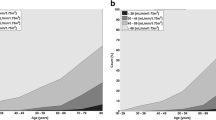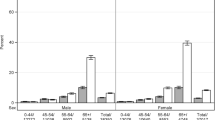Abstract
The CKD-EPI equation is more accurate than the MDRD equation in the general population. We performed this study to establish whether chronic kidney disease (CKD) is commonly recognized by clinicians and whether the CKD-EPI equation improves prognosis estimation in patients with chronic cardiovascular disease (CVD). We analyzed data on 12394 CVD patients consecutively examined at the Cardiovascular Center of Trieste (Italy) between November 2009 and October 2013. The outcomes were all-cause death and a composite outcome of death/hospitalization for CV events (D+cvH). CKD-EPI formula reclassified 1786 (14.4 %) patients between KDIGO categories compared to the MDRD: 2.3 % (n = 280) placed in a lower risk and 12.1 % (n = 1506) into a higher risk group. CKD, defined as eGFR-CKD-EPI formula <60 ml/min, was present in 3083 patients (24.9 %) but not recognized by clinicians in 1946 (63.1 % of patients with CKD). The lack of recognition of CKD was inversely proportional to the KDIGO class for both equations. There were 986 deaths and 2726 D+cvH during 24 months follow-up. The incidence of death and D+cvH was about twice as high in patients with unrecognized CKD than in those with normal renal function (31 % vs. 17.1 %, aHR: 1.35, 95 % CI: 1.15 to 1.60), even in those patients with eGFR-MDRD >60 but eGFR-CKD-EPI formula <60 (31.1 % vs 17.1 %, p < 0.001). CKD-EPI equation provides more accurate risk stratification than MDRD equation in patients with CVD. CKD was unrecognized in nearly two-thirds of these patients but clinical outcomes were similar in those for patients with recognized CKD.



Similar content being viewed by others
References
Go AS, Chertow GM, Fan D, McCulloch CE, Hsu CY (2004) Chronic kidney disease and the risks of death, cardiovascular events, and hospitalization. N Engl J Med 351:1296–1305
McCullough PA, Li S, Jurkovitz CT, Stevens L, Collins AJ, Chen SC, Norris KC, McFarlane S, Johnson B, Shlipak MG, Obialo CI, Brown WW, Vassalotti J, Whaley-Connell AT, Brenner RM (2008) Bakris GL; KEEP Investigators. Chronic kidney disease, prevalence of premature cardiovascular disease, and relationship to short-term mortality. Am Heart J 156:277–283
Meisinger C, Döring A (2006) Löwel H; KORA Study Group. Chronic kidney disease and risk of incident myocardial infarction and all-cause and cardiovascular disease mortality in middle-aged men and women from the general population. Eur Heart J 27:1245–1250
Ezekowitz J, McAlister FA, Humphries KH, Norris CM, Tonelli M, Ghali WA (2004) Knudtson ML; APPROACH Investigators. The association among renal insufficiency, pharmacotherapy, and outcomes in 6,427 patients with heart failure and coronary artery disease. J Am Coll Cardiol 44:1587–1592
Perk J, De Backer G, Gohlke H, Graham I, Reiner Z, Verschuren M, Albus C, Benlian P, Boysen G, Cifkova R, Deaton C, Ebrahim S, Fisher M, Germano G, Hobbs R, Hoes A, Karadeniz S, Mezzani A, Prescott E, Ryden L, Scherer M, Syvänne M, Scholte op Reimer WJ, Vrints C, Wood D, Zamorano JL, Zannad F, European Association for Cardiovascular Prevention & Rehabilitation (EACPR), ESC Committee for Practice Guidelines (CPG) (2012) European Guidelines on cardiovascular disease prevention in clinical practice (version 2012). The Fifth Joint Task Force of the European Society of Cardiology and Other Societies on Cardiovascular Disease Prevention in Clinical Practice (constituted by representatives of nine societies and by invited experts). Eur Heart J 33:1635–1701
McClellan WM, Langston RD, Presley R (2004) Medicare patients with cardiovascular disease have a high prevalence of chronic kidney disease and a high rate of progression to end-stage renal disease. J Am Soc Nephrol 15:1912–1919
Sud M, Tangri N, Pintilie M, Levey AS, Naimark D (2014) Risk of end-stage renal disease and death after cardiovascular events in chronic kidney disease. Circulation 130:458–465
Amsalem Y, Garty M, Schwartz R, Sandach A, Behar S, Caspi A, Gottlieb S, Ezra D, Lewis BS, Leor J (2008) Prevalence and significance of unrecognized renal insufficiency in patients with heart failure. Eur Heart J 29:1029–1036
Ko DT, Juurlink DN, Mamdani MM, You JJ, Wang JT, Donovan LR, Tu JV (2006) Appropriateness of spironolactone prescribing in heart failure patients: a population-based study. J Card Fail 12:205–210
Corsonello A, Pedone C, Corica F, Mussi C, Carbonin P (2005) Antonelli Incalzi R; Gruppo Italiano di Farmacovigilanza nell’Anziano (GIFA) Investigators. Concealed renal insufficiency and adverse drug reactions in elderly hospitalized patients. Arch Intern Med 165:790–795
Kidney Disease: Improving Global Outcomes (KDIGO) CKD Work Group. KDIGO (2012) Clinical practice guideline for the evaluation and management of chronic kidney disease. Kidney inter (Suppl) 2013(3):1–150
Levey AS, Bosch JP, Lewis JB, Greene T, Rogers N, Roth D (1999) A more accurate method to estimate glomerular filtration rate from serum creatinine: a new prediction equation. Modification of Diet in Renal Disease Study Group. Ann Intern Med 130:461–470
Bostom AG, Kronenberg F, Ritz E (2002) Predictive performance of renal function equations for patients with chronic kidney disease and normal serum creatinine levels. J Am Soc Nephrol 13:2140–2144
Rule AD, Larson TS, Bergstralh EJ, Slezak JM, Jacobsen SJ, Cosio FG (2004) Using serum creatinine to estimate glomerular filtration rate: accuracy in good health and in chronic kidney disease. Ann Intern Med 141:929–937
Glassock RJ, Winearls C (2008) An epidemic of chronic kidney disease: fact or fiction? Nephrol Dial Transplant 23:1117–1121
Levey AS, Stevens LA, Schmid CH, Zhang YL, Castro AF 3rd, Feldman HI, Kusek JW, Eggers P, Van Lente F, Greene T (2009) Coresh J; CKD-EPI (chronic kidney disease epidemiology collaboration). A new equation to estimate glomerular filtration rate. Ann Intern Med 150:604–612
Earley A, Miskulin D, Lamb EJ, Levey AS, Uhlig K (2012) Estimating equations for glomerular filtration rate in the era of creatinine standardization: a systematic review. Ann Intern Med 156:785–795
Matsushita K, Mahmoodi BK, Woodward M, Emberson JR, Jafar TH, Jee SH, Polkinghorne KR, Shankar A, Smith DH, Tonelli M, Warnock DG, Wen CP, Coresh J, Gansevoort RT, Hemmelgarn BR, Levey AS (2012) Chronic kidney disease prognosis consortium. comparison of risk prediction using the CKD-EPI equation and the MDRD study equation for estimated glomerular filtration rate. JAMA 307:1941–1951
Matsushita K, Selvin E, Bash LD, Astor BC, Coresh J (2010) Risk implications of the new CKD Epidemiology Collaboration (CKD-EPI) equation compared with the MDRD Study equation for estimated GFR: the Atherosclerosis Risk in Communities (ARIC) Study. Am J Kidney Dis 55:648–659
White SL, Polkinghorne KR, Atkins RC, Chadban SJ (2010) Comparison of the prevalence and mortality risk of CKD in Australia using the CKD Epidemiology Collaboration (CKD-EPI) and Modification of Diet in Renal Disease (MDRD) Study GFR estimating equations: the AusDiab (Australian Diabetes, Obesity and Lifestyle) Study. Am J Kidney Dis 55:660–670
Matsushita K, Tonelli M, Lloyd A, Levey AS, Coresh J, Hemmelgarn BR, Alberta Kidney Disease Network (2012) Clinical risk implications of the CKD Epidemiology Collaboration (CKD-EPI) equation compared with the Modification of Diet in Renal Disease (MDRD) Study equation for estimated GFR. Am J Kidney Dis 60:241–249
Shafi T, Matsushita K, Selvin E, Sang Y, Astor BC, Inker LA, Coresh J (2012) Comparing the association of GFR estimated by the CKD-EPI and MDRD study equations and mortality: the third national health and nutrition examination survey (NHANES III). BMC Nephrol 13:42–52
Skali H, Uno H, Levey AS, Inker LA, Pfeffer MA, Solomon SD (2011) Prognostic assessment of estimated glomerular filtration rate by the new Chronic Kidney Disease Epidemiology Collaboration equation in comparison with the Modification of Diet in Renal Disease Study equation. Am Heart J 162:548–554
McAlister FA, Ezekowitz J, Tarantini L, Squire I, Komajda M, Bayes-Genis A, Gotsman I, Whalley G, Earle N, Poppe KK, Doughty RN, Meta-analysis Global Group in Chronic Heart Failure (MAGGIC) Investigators (2012) Renal dysfunction in patients with heart failure with preserved versus reduced ejection fraction: impact of the new Chronic Kidney Disease-Epidemiology Collaboration Group formula. Circ Heart Fail 5:309–314
Lip GY, Felmeden DC, Li-Saw-Hee FL, Beevers DG (2000) Hypertensive heart disease. A complex syndrome or a hypertensive ‘cardiomyopathy’? Eur Heart Journal 21:1653–1665
(1998) Clinical guidelines on the identification, evaluation, and treatment of overweight and obesity in adults—the evidence report. National institutes of health. Obes Res Suppl 2:51S–209S
WHO Expert Committe on Diabetes Mellitus (1980). Second Report. Geneva, Switzerland: World Health Organization; Technical Report Series 646
Kilbride HS, Stevens PE, Eaglestone G, Knight S, Carter JL, Delaney MP, Farmer CK, Irving J, O’Riordan SE, Dalton RN, Lamb EJ (2013) Accuracy of the MDRD (Modification of Diet in Renal Disease) study and CKD-EPI (CKD Epidemiology Collaboration) equations for estimation of GFR in the elderly. Am J Kidney Dis 61:57–66
Heywood JT, Fonarow GC, Costanzo MR, Mathur VS, Wigneswaran JR, Wynne J, ADHERE Scientific Advisory Committee and Investigators (2007) High prevalence of renal dysfunction and its impact on outcome in 118,465 patients hospitalized with acute decompensated heart failure: a report from the ADHERE database. J Card Fail 13:422–430
Chronic Kidney Disease Prognosis Consortium, Matsushita K, van der Velde M, Astor BC, Woodward M, Levey AS, de Jong PE, Coresh J, Gansevoort RT (2010) Association of estimated glomerular filtration rate and albuminuria with all-cause and cardiovascular mortality in general population cohorts: a collaborative meta-analysis. Lancet 375:2073–2081
Kongkaew C, Noyce PR, Ashcroft DM (2008) Hospital admissions associated with adverse drug reactions: a systematic review of prospective observational studies. Ann Pharmacother 42:1017–1025
Manns B, Tonelli M, Culleton B, Faris P, McLaughlin K, Chin R, Gooch K, McAlister FA, Taub K, Thorlacius L, Krause R, Kearns M, Hemmelgarn B, Alberta Kidney Disease Network (2012) A cluster randomized trial of an enhanced eGFR prompt in chronic kidney disease. Clin J Am Soc Nephrol 7:565–572
Wang V, Maciejewski ML, Hammill BG, Hall RK, Van Scoyoc L, Garg AX, Jain AK, Patel UD (2014) Recognition of CKD after the introduction of automated reporting of estimated GFR in the Veterans Health Administration. Clin J Am Soc Nephrol 9:29–36
Tarantini L, Cioffi G, Gonzini L, Oliva F, Lucci D, Di Tano G, Maggioni AP, Tavazzi L, Italian Acute Heart Failure Survey (2010) Evolution of renal function during and after an episode of cardiac decompensation: results from the Italian survey on acute heart failure. J Cardiovasc Med 11(4):234–243
Conflict of interest
None.
Statement of human and animal rights
All procedures performed in studies involving human participants were in accordance with the ethical standards of the institutional or national research committee and with the 1964 Helsinki declaration and its later amendments or comparable ethical standards.
Informed consent
Informed consent was obtained from all individual participants included in the study.
Author information
Authors and Affiliations
Corresponding author
Rights and permissions
About this article
Cite this article
Tarantini, L., Barbati, G., Cioffi, G. et al. Clinical implications of the CKD epidemiology collaboration (CKD-EPI) equation compared with the modification of diet in renal disease (MDRD) study equation for the estimation of renal dysfunction in patients with cardiovascular disease. Intern Emerg Med 10, 955–963 (2015). https://doi.org/10.1007/s11739-015-1260-2
Received:
Accepted:
Published:
Issue Date:
DOI: https://doi.org/10.1007/s11739-015-1260-2




